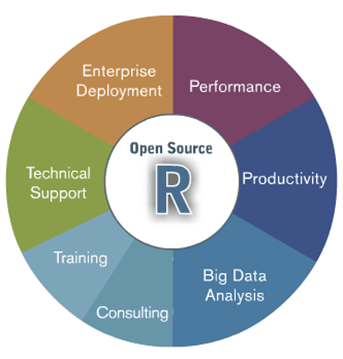 How R Programming Is Applied To R-eal World
How R Programming Is Applied To R-eal World
Around the world, millions of analysts and data researchers use R Programming to take care of their most difficult issues in the fields running from computational science to extensive marketing. R Programming, or R, has turned into the most prevalent language for data science and a fundamental tool for Finance and analytics-driven organizations, for example, Google, Facebook, and LinkedIn.
R is a language and environment for statistical computing and design. It is a GNU venture which is like the S language and environment which was created at Bell Laboratories by John Chambers and Associates. R Programming has brought revolutionary modifications in Big Data Analytics and other aspects of data analytics and data science. R Programming can be considered as an alternate execution of S. There are some dynamic contrasts. However, much code composed for S runs unaltered under R.
 R Programming gives a broad variety of statistical (direct and nonlinear modeling), traditional statistical tests, time-arrangement analysis, grouping, bunching and graphical techniques, and is profoundly extensible. The S language is regularly the vehicle of decision for exploration in statistical methodology, and R gives an Open Source route to cooperation in that action.
R Programming gives a broad variety of statistical (direct and nonlinear modeling), traditional statistical tests, time-arrangement analysis, grouping, bunching and graphical techniques, and is profoundly extensible. The S language is regularly the vehicle of decision for exploration in statistical methodology, and R gives an Open Source route to cooperation in that action.
R Programming applications compass the universe from hypothetical, computational statistics and the hard sciences, for example, astronomy, chemistry, and genomics to practical applications in business, drug advancement, finance, health care, marketing, medicine and much more. Since R has almost 5,000 packages (libraries of functions) large portions of which are committed to particular applications, you don't need to be an R Programming genius to begin developing your applications.

Many quantitative analysts in finance use R Programming as their primary programming tool. Once you get the hang of it, it's good for everything from data import and cleaning, investigation and visualization, doing statistics and analyzes, all the route up to dealing simulations and generation trading applications, depending on what manner of strategy you're operating on.
Why Should You Adopt R Programming?
R Programming is the best mechanism for statistics, data analysis, and machine learning. It is more than a statistical package; it’s a programming language so that you can create your objects, functions, and packages.
Like all applications, R programs explicitly record the actions of analysis and make it easy to reproduce and update report, which means it can quickly try many ideas and factual issues.
It can easily use it anywhere. It’s platform-independent, so it can apply it to each operating system. And it’s free, so it can implement it in any organization without purchasing a license.
Not solely is R Programming free, but it’s also open-source. That means anyone can examine the source code to see exactly what it’s doing. This also means that anyone, can fix bugs and add features, rather than waiting for the vendor to find/fix the bug and add the feature –at their discretion– in a future release.
R Programming allows to integrate with other languages (C/C++, Java, Python) and enables to communicate with many data sources: ODBC-compliant databases (Excel, Access) and other statistical packages (SAS, Stata, SPSS, Minitab).
I personally like [R] considering that it’s very convenient to software in from an extra computer science-y level. And R has gotten faster over time and serves as a glue language for piecing together different data sets, tools, or software packages.
R Programming is the best approach to create reproducible, excessive-quality analysis. It has all of the flexibility and power I'm looking for when dealing with data. Many of the applications I write in R are sincerely just collections of scripts which are equipped into tasks.
It's utilized in almost every field that you could think of. Nonetheless the widespread ones comprise - Finance, Bio Science, Supply chain, Sports, Retail, Marketing, and Manufacturing.
Many quantitative analysts in finance use R as their major programming instrument. While you get the dangle of it, it is just right for everything from data import and cleaning, exploration and visualization, doing statistics and analyses, all of the approach up to trading simulations and production buying and selling functions, relying on what kind of process you are working on.
Google is utilizing R Programming and it is a satisfactory language for doing any form of statistics or data manipulation/visualization, however, IMHO, its power lies in the constructed-in capabilities and libraries instead than its strengths as a language itself (syntax, design, readability, and so forth.)
Of these three statistical languages, R is the only one that's open source. SAS is the most important privately held software enterprise in the world, and SPSS is now shepherded through IBM.
R and its libraries put in force a vast kind of statistical and graphical techniques, together with linear and non-linear modeling, classical statistical exams, time-sequence analysis, classification, clustering, and others. R Programming is comfortably extensible via the services and extensions, and the R group is noted for its energetic contributions in terms of applications. Lots of R's typical features are written in R itself, which makes it handy for users to follow the algorithmic selections made. For computationally intensive duties, C, C++, and Fortran code will also be linked and called at run time. Developed users can write C, C++, Java, .NET or Python code to control R objects immediately.







